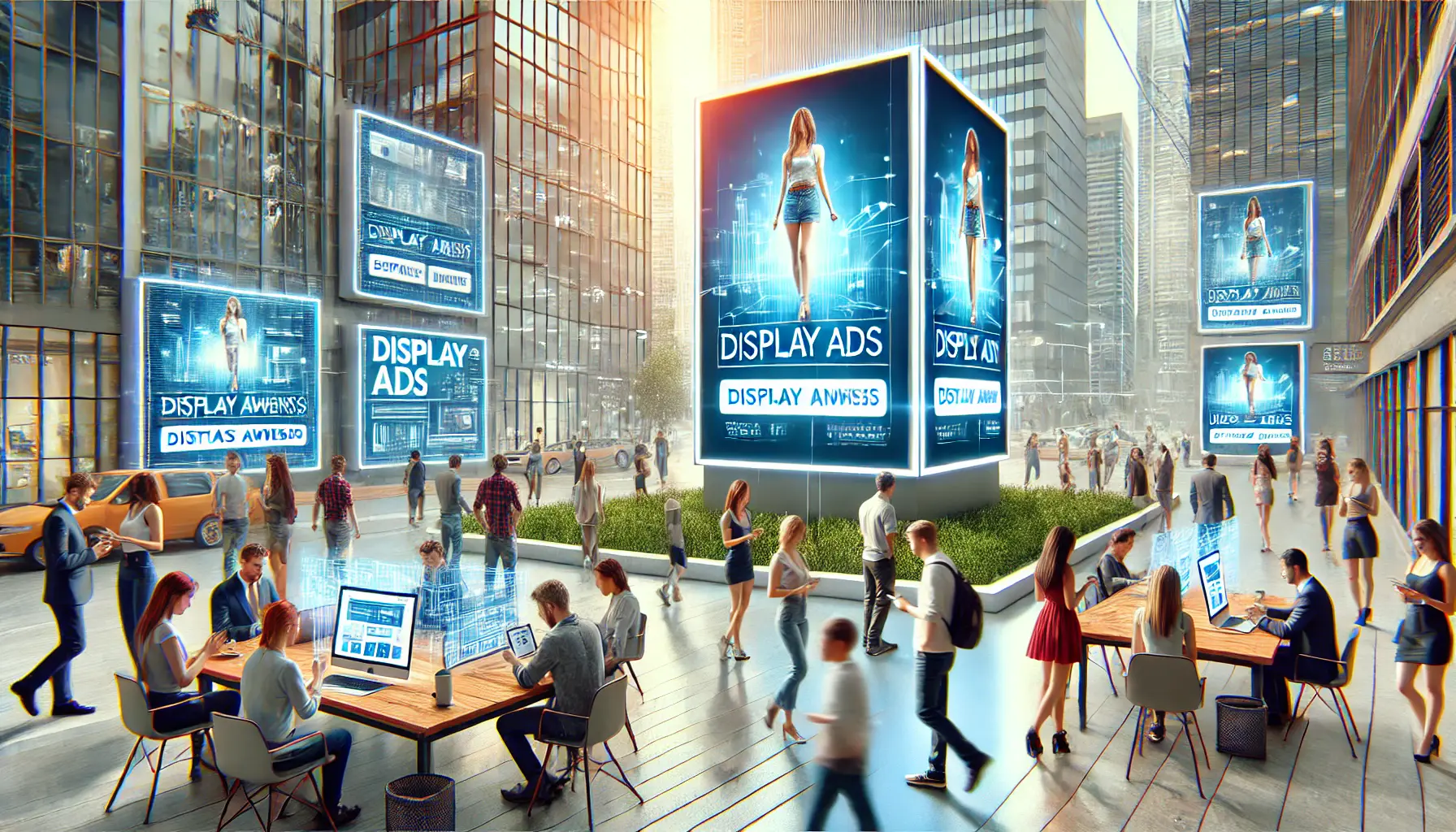In today’s digital landscape, establishing strong brand awarenessThe extent to which consumers recognize and recall a brand. is crucial for businesses aiming to stand out in a crowded market.
One effective method to achieve this is through display advertisingA form of online advertising that uses visual elements like banners, images, and videos..
By leveraging visual elements, display ads can significantly enhance your brand’s visibility and recognition among potential customers.
Let’s delve into how display ads play a pivotal role in building brand awareness.
- Understanding the Role of Display Ads in Brand Awareness
- Utilizing Targeted Messaging for Audience Relevance
- Leveraging Remarketing to Reinforce Brand Recall
- Integrating Analytics for Insight-Driven Strategy
- Enhancing Brand Awareness Through Video Display Ads
- Key Takeaways for Building Brand Awareness with Display Ads
- Display Ad Brand Awareness Frequently Asked Questions
Understanding the Role of Display Ads in Brand Awareness
Display advertising involves showing advertisements to users on third-party websites, apps, or social media platforms to draw attention to a brand or product.
These ads can take the form of banners, images, videos, or even interactive pieces designed to attract the viewer’s attention.
By strategically placing display ads across different platforms, businesses can achieve the following:
- Brand visibility: Consistent exposure to your brand via display ads embeds your brand into the minds of consumers, enhancing brand recall when it is time to make a purchasing decision.
- Target your audience: Display ads allow precise targeting based on demographics, interests, and browsing behavior, ensuring that the right potential customers see your brand.
- Improve brand perception: Artfully designed display ads can effectively communicate your brand’s message and values, positively influencing consumer perceptions about your brand.
In my experience, incorporating display ads into any marketing mix has noticeably increased brand recall and customer interaction.
How do you think display advertising could enhance your brand’s presence in the digital space?
Display ads are a cornerstone of brand visibility, embedding your brand into consumer awareness through consistent exposure.
- Strategically placed ads enhance brand recall.
- Engaging visuals positively influence brand perception.

Illustration of targeted messaging for achieving audience relevance in digital marketing.
Utilizing Targeted Messaging for Audience Relevance
In the realm of display advertising, delivering the right message to the right audience is paramount.
Targeted messaging ensures that your advertisements resonate with specific groups, enhancing engagement and conversion rates.
Let’s explore how to effectively implement targeted messaging in your display ad campaigns.

Professionals in a meeting room discussing target audience identification using digital tools and data analysis.
Identifying Your Target Audience
Understanding who your ideal customers are is the first step in crafting relevant messages.
Consider factors such as:
- Demographics: Age, gender, income level, educational background, and occupation.
- Psychographics: Interests, values, lifestyles, and personality traits.
- Behavioral Data: Purchase history, website behaviors, and product interests.
By analyzing these dimensions, you can create detailed buyer personas to inform your ad content and placement strategy.

A team collaborating on designing personalized advertisements in a sleek, modern office.
Designing Personalized Ad Content
Once you identify your target audience, shape the ad content to meet their specific needs and preferences.
Personalized advertising has been shown to increase engagement by delivering messages that are directly relevant to consumers’ interests and behaviors.
Here are some strategies:
- Dynamic Creative: Use technology to automatically personalize ad elements such as images, headlines, or calls-to-action based on user data. This allows every viewer to see the most relevant version of your ad.
- Behavioral Retargeting: Advertise to users based on their past interactions with your website or products. For instance, if a user viewed a product but didn’t buy it, show them an ad featuring that product.
- Contextual Relevance: Align your ad content with the context of the websites or platforms where your ads appear. This strategy increases the likelihood that users will find your ads pertinent and engaging.

Visualizing the benefits of audience-specific messaging in a modern digital marketing environment.
Benefits of Audience-Specific Messaging
Implementing targeted messaging in your display ads offers several advantages:
- Increased Engagement: Ads that speak directly to the viewer’s interests are more likely to capture attention and prompt interaction.
- Higher Conversion Rates: Personalized ads can lead to higher conversion rates, as the advertising message precisely responds to the needs and wants of targeted customers.
- Improved Return on Investment (ROI): Concentrating your ad efforts on the most relevant audiences ensures effective usage of your marketing budget, driving superior returns.
My experience is that targeted messaging within display advertising not only positively affects audience engagement but also adds significant value to interactions with prospective customers.
Have you considered how personalized ad content could elevate your marketing efforts?
Crafting personalized messages for your audience ensures higher engagement and conversion rates. Utilize dynamic creativeAdvertising content that is automatically personalized based on user data. and behavioral retargetingA strategy of serving ads to users based on their previous interactions with a website or product. for maximum relevance.
- Dynamic creative adapts content to user data.
- Contextual relevance aligns ads with platform context.

Illustrating the use of remarketing strategies to reinforce brand recall and re-engage past customers.
Leveraging Remarketing to Reinforce Brand Recall
In the competitive landscape of digital marketing, maintaining brand awareness among potential customers is essential.
Remarketing, also known as retargeting, is a powerful strategy that enables businesses to reconnect with users who have previously interacted with their website or mobile app.
By displaying targeted ads to these users as they browse other sites or platforms, you can reinforce brand recall and encourage return visits.
Let’s explore how to effectively implement remarketingA digital marketing strategy targeting users who previously interacted with a website or app. in your display advertising campaigns.

Understanding how remarketing works through customer data and retargeted ads in a modern digital marketing environment.
Understanding Remarketing
Remarketing involves tracking visitors to your website or app and serving them tailored ads as they navigate other parts of the internet.
This strategy keeps your brand at the forefront of their minds, increasing the likelihood of conversion upon their return.
There are two primary types of remarketing:
- Standard Remarketing: Displays generic ads to past visitors as they browse other sites within the Google Display Network or social media platforms. This approach helps maintain brand awareness and fosters renewed interest.
- Dynamic Remarketing: Shows personalized ads featuring specific products or services that users viewed on your site. This method delivers highly relevant content, enhancing the chances of conversion.

Digital marketing team planning a remarketing campaign with customer data and campaign strategy visualization.
Setting Up Effective Remarketing Campaigns
To create a successful remarketing campaign, consider the following steps:
- Define Your Audience Segments: Categorize visitors based on their behavior, such as pages visited, time spent on site, or actions taken (e.g., adding items to a cart). This segmentation allows for more personalized ad delivery.
- Develop Compelling Ad Creatives: Create ads that resonate with each audience segment. For dynamic remarketing, ensure that product images and descriptions are accurate and appealing.
- Set Frequency Caps: Limit the number of times an ad is shown to the same user to prevent ad fatigue and negative perceptions of your brand.
- Utilize Cross-Channel Remarketing: Implement remarketing strategies across platforms, including social media and email, for a cohesive and comprehensive approach that reaches users wherever they are active online.

Measuring the success of remarketing campaigns with performance data analysis and key metrics.
Measuring the Success of Remarketing Efforts
The performance of your remarketing campaigns needs to be measured for continuous optimization.
Key metrics to track include:
- Click-Through Rate (CTR): Measures how often users click on your ads, indicating relevance and appeal.
- Conversion Rate: Indicates the percentage of people taking action after clicking your ad, such as signing up for a newsletter or making a purchase.
- Return on Ad Spend (ROAS): Calculates the revenue generated for every dollar spent on ads, helping determine the overall effectiveness of the campaign.
By regularly analyzing these metrics, you can refine your remarketing strategies to ensure they effectively reinforce brand recall and drive conversions.
In my experience, well-structured remarketing campaigns increase brand awareness and customer retention.
Have you thought about how remarketing can help strengthen your brand and encourage repeat customer interactions?
Remarketing is vital for reconnecting with past visitors, keeping your brand at the forefront of their minds.
- Dynamic remarketing delivers personalized product ads.
- Frequency caps prevent ad fatigue.

Integrating analytics into digital marketing strategies through detailed data analysis.
Integrating Analytics for Insight-Driven Strategy
In the dynamic world of display advertising, leveraging analytics is essential for crafting strategies that enhance brand awareness.
By analyzing key metrics, you can gain valuable insights into your campaign’s performance and make informed decisions to optimize your advertising efforts.
Let’s explore the critical metrics to monitor and the tools that can assist in this process.

Analyzing key metrics for optimizing display advertising performance.
Key Metrics to Monitor in Display Advertising
To effectively measure the performance of your display advertising campaigns, pay attention to the following metrics:
- Click-Through Rate (CTR): The percentage of users that click on your ad once they have seen it. This metric indicates the ad’s relevance and appeal. A high CTR suggests your ad resonates well with your target audience.
- Conversion Rate: The percentage of users taking a desired action, such as making a purchase or signing up for a newsletter, after clicking on your ad. This metric reflects how well your ad is converting users.
- Cost Per Acquisition (CPA): Calculates the average cost to acquire a new customer or lead through your advertising efforts. Monitoring CPA helps evaluate the cost-effectiveness of your campaigns.
- Return on Ad Spend (ROAS): Assesses the revenue generated for every dollar spent on advertising, providing insight into the profitability of your campaigns. A higher ROAS indicates a more efficient use of your advertising budget.
- Impressions: Represents the total number of times your ad is displayed, offering an overview of its reach. While impressions alone don’t guarantee engagement, they are crucial for building brand awareness.
- Viewability Rate: Measures the percentage of your ads that are actually seen by users, ensuring that your ads have the opportunity to make an impact. High viewability is essential for effective brand exposure.
Using advanced tools to track and analyze display advertising performance in a modern digital marketing environment.
Tools for Tracking and Analysis
Utilizing advanced analytics tools can streamline the process of monitoring these metrics and provide deeper insights into your campaigns.
Here are some noteworthy tools:
- Google Analytics: Offers comprehensive reporting features that help you understand user behavior and measure ad performance. It allows for custom reporting, conversion tracking, and demographic analysis, making it indispensable for marketers.
- Google Marketing Platform: Integrates various advertising and analytics services, providing a unified view of your marketing efforts. It includes tools like Display & Video 360 and Search Ads 360, enabling real-time data analysis and campaign optimization.
- Hevo Data: Provides seamless integration with the Google Marketing Suite, allowing for efficient data collection and analysis. It enables marketers to create remarketing audiences based on specific behaviors, demographics, and interests, enhancing ad relevance.
- SegmentStream: Features advanced conversion modeling capabilities that help identify profitable channels and campaigns. Its insights assist advertisers in allocating budgets more effectively, ensuring funds are directed toward the most impactful strategies.
My experience has been that integrating these analytics tools into your display advertising strategy enhances not only your understanding of campaign performance but also empowers you to make data-driven decisions that amplify brand awareness.
How do you think accessing these metrics and tools might elevate your advertising?
Analytics enable data-driven decisions, optimizing ad performance and ensuring effective budget allocation.
- Track metrics like CTR, conversion rates, and ROAS.
- Use tools like Google Analytics for deeper insights.

Using video display ads to enhance brand awareness and create emotional connections with the audience.
Enhancing Brand Awareness Through Video Display Ads
Incorporating video into your display advertising strategy can significantly boost brand awareness.
Videos are inherently engaging, capturing attention more effectively than static images.
Let’s explore the benefits of video display ads and best practices for creating compelling content.

Illustrating the benefits of video display ads in driving engagement and enhancing brand recognition.
Benefits of Video Display Ads
Utilizing video in display advertising offers several advantages:
- Stronger Engagement: Videos hold greater engagement than static images. They can deliver complex messages succinctly, making them ideal for attracting audience attention immediately.
- Wider Reach: Video ads achieve better reach across multiple platforms, enhancing brand presence. With the rise of YouTube and social media channels, video content has become a primary method for reaching customers and viewers.
- Improved Conversion Rates: Engaging video content can lead to higher conversion rates by effectively conveying your brand’s message and value proposition. Videos evoke emotions and build trust, influencing purchasing decisions.

Team collaborating to optimize video display ads for better engagement and effectiveness.
Best Practices for Creating Effective Video Display Ads
To maximize the impact of your video display ads, consider the following best practices:
- Keep It Concise: Shorter videos are more likely to be watched entirely than longer ones, especially given the decreasing attention spans of online audiences. For instance, videos under 90 seconds have a 50% retention rate.
- Focus on Storytelling: Craft a compelling narrative that resonates with your target audience. Storytelling makes your brand more memorable and relatable, fostering a deeper connection with viewers.
- Include a Clear Call-to-Action (CTA): Guide viewers toward the desired action, such as visiting your website, signing up for a newsletter, or making a purchase. A strong CTA significantly enhances the effectiveness of your ad.
- Mobile Optimization: Ensure your videos are mobile-friendly, as many users access content through their mobile devices. Use appropriate aspect ratios and file sizes for seamless playback on smartphones and tablets.
- Performance Testing and Analysis: Monitor performance metrics such as view-through rates and conversions. Regularly analyze this data to refine your strategy and improve results over time.
From my experience, incorporating video into display advertising not only improves brand awareness but also fosters higher engagement and conversion.
Have you considered how video display ads could elevate your brand’s presence in the digital landscape?
Video ads are unparalleled in capturing attention and delivering engaging content.
- Shorter videos have higher retention rates.
- Storytelling enhances emotional connection with viewers.

Digital marketing team analyzing key strategies for building brand awareness using display ads.
Key Takeaways for Building Brand Awareness with Display Ads
Display advertising is a powerful tool for building brand awareness in the competitive digital landscape.
By leveraging creative strategies, targeted messaging, and advanced analytics, businesses can create impactful campaigns that resonate with their audience and drive measurable results.
Let’s summarize the core insights from the article.

Showcasing the impact of display ads on brand awareness in an urban environment.
The Importance of Display Ads in Brand Awareness
Display ads play a pivotal role in enhancing brand visibility by strategically reaching your target audience.
They offer a platform for delivering visually engaging content that reinforces your brand’s presence, making them indispensable in any digital marketing strategy.

Marketing team discussing four proven tactics for success in digital advertising, including targeting, remarketing, video ads, and data analytics.
Four Proven Tactics for Success
Throughout the article, we’ve explored key tactics to maximize the effectiveness of display ads in building brand awareness.
Here’s a quick recap:
- Understanding the Role of Display Ads: Establish how visual ads drive brand recognition and engage with consumers.
- Targeted Messaging: Employ precise audience segmentation and personalization to reach users with ads that correspond to their interests, fostering greater engagement and conversion.
- Remarketing Strategies: Connect again with past visitors by serving them targeted ads that enhance brand recall and encourage return visits.
- Video Integration: Enhance engagement and emotional connection with video display ads, leveraging storytelling and concise messaging for better results.

Using analytics to drive continuous improvement in digital marketing strategies.
Leveraging Analytics for Continuous Improvement
Analytics are at the heart of effective display advertising.
By monitoring key metrics such as CTR, conversion rates, and ROAS, businesses can identify strengths and weaknesses in their campaigns.
Employing tools like Google Analytics and SegmentStream enables marketers to make data-driven decisions, ensuring their strategies evolve to meet audience expectations.

Delivering final insights and strategies for future digital marketing success.
Final Thoughts
To be successful in today’s competitive environment, businesses must innovate their approach to display advertising.
From leveraging the engaging nature of video to optimizing ad placements and using analytics for precision, these tactics together empower brands to rise above the noise and thrive.
How will you apply these methods to improve your brand awareness through display advertising?
An integrated and creative approach will go a long way in building a strong brand presence that resonates with your audience and secures long-term success.
Integrating creative strategies, targeted messaging, and analytics builds strong brand awareness in the digital space.
- Leverage video and remarketing for enhanced recall.
- Continuously optimize campaigns with data insights.

Marketing team analyzing frequently asked questions related to display ads and brand awareness.
Your campaigns can be managed by an agency specialized in Google Ads, check out our service page.
Display Ad Brand Awareness Frequently Asked Questions
The main objective of display advertising is to create brand awareness by exposing your brand on websites or apps, driving clicks that lead to landing pages with effective CTAs.
Display ads enhance brand visibility by placing your brand front and center before relevant audiences, increasing the likelihood of recognition and recall.
Banner ads, native ads, and video ads are commonly used in display advertising to promote products, services, and content, each offering unique advantages for brand awareness.
Success can be measured using metrics such as click-through rates (CTR), conversion rates, and return on ad spend (ROAS), providing insights into campaign performance.
Audience targeting allows advertisers to define their target demographics and serve ads precisely to those audiences, enhancing relevance and engagement.
Remarketing, also known as retargeting, helps brands reconnect with audiences who previously visited their site, reinforcing brand awareness and encouraging conversions.
Video ads can deliver involved messages succinctly, attracting audience attention immediately and leading to higher engagement compared to static images.
Optimizing display ads involves creating visually appealing and concise ads, using compelling calls to action, and A/B testing ad options for optimization.
Display ads are clearly advertisements, while native ads are designed to blend in with the content of the websites or apps they’re displayed on, providing a less intrusive advertising experience.












